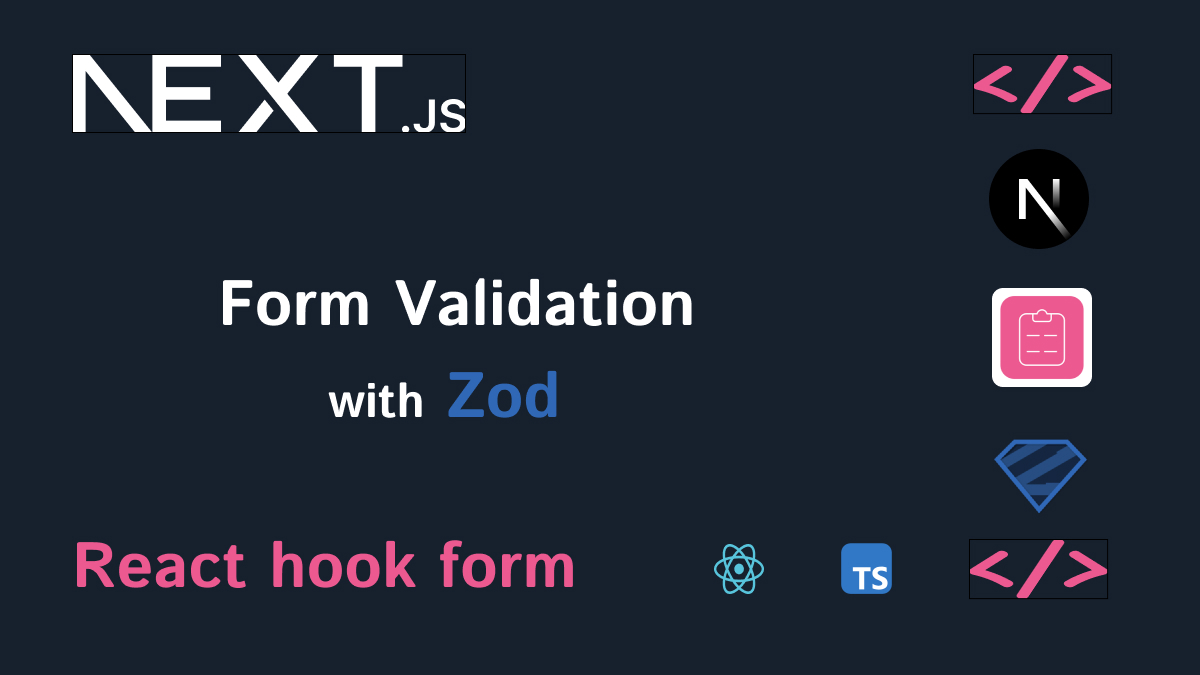Forms with Zod Validation in Next.js
 Binay Maharjan
Binay Maharjan
Forms are a common feature in web applications. They are used to collect user input and submit it to a server. However, it is important to validate form data before submitting it to ensure it is accurate and complete. We will show you how to create forms with validation in Next.js using Zod, React Hook Form, and Zod Resolver. For the UI parts of forms, we choose Shadcn which is not a component library but It's a collection of reusable components that you can copy and paste into your apps
What is Zod?
Zod is a powerful TypeScript validation library that provides a simple and intuitive way to define and validate data structures. It is designed to work seamlessly with TypeScript's type system, offering type safety and reducing the likelihood of runtime errors. Learn more
What is React Hook Form?
React Hook Form is a library that simplifies form handling in React by providing custom hooks and utility functions. It offers features such as controlled inputs, validation, and form submission. Learn more
What is Zod Resolver?
Zod Resolver is a utility library that integrates Zod schemas with React Hook Form, providing a seamless way to validate form data using Zod. Learn more
How to Create a Form with Validation in Next.js
Create a new Next.js project or an existing Next.js project.
Install these packagesnpm install react-hook-form //Installing React Hook Form npm install zod // Installing zod package npm install @hookform/resolvers //Installing React Hook Form resolveInstall Zod, React Hook Form, and Zod Resolver.Create a new component called basic-form.tsx which contains the form and inputs. We use Shadcn ui for the form elements. To get work of this basic form we have to install shadcn first and then form, input, and button. Like
npm install shadcn init
npm install form input button"use client" import { Form, FormControl, FormField, FormItem, FormLabel, } from "@/components/ui/form" import { Input } from "@/components/ui/input" import { Button } from "@/components/ui/button" export function BasicForm() { return ( <Form {...form}> <form onSubmit={form.handleSubmit(onSubmit)} className="w-2/3 space-y-6"> <FormField control={form.control} name="name" render={({ field }) => ( <FormItem> <FormLabel>Name</FormLabel> <FormControl> <Input placeholder="Enter name" {...field} /> </FormControl> </FormItem> )} /> <FormField control={form.control} name="email" render={({ field }) => ( <FormItem> <FormLabel>Email</FormLabel> <FormControl> <Input placeholder="Enter email" {...field} /> </FormControl> </FormItem> )} /> <FormField control={form.control} name="password" render={({ field }) => ( <FormItem> <FormLabel>Password</FormLabel> <FormControl> <Input type="password" placeholder="Enter Password" {...field} /> </FormControl> </FormItem> )} /> <Button type="submit">Submit</Button> </form> </Form> ) }Define a Zod schema for the form data.
const formSchema = z.object({ name: z.string().min(2), email: z.string().email(), password: z.string().min(6), })Integrate the Zod schema with React Hook Form using Zod Resolver.
const form = useForm<z.infer<typeof formSchema>>({ resolver: zodResolver(formSchema), defaultValues: { name:'', email:'example@gmail.com', //we can give default values too password:'' } })Add error messages to the form to display validation errors.
const formSchema = z.object({ name: z.string().min(2,{ message: "Name must be at least 2 characters.", }), email: z.string().email({ message: "Please enter a valid email address" }), password: z.string().min(6,{ message: "Password must be of 6 character" }), })Submit the form and handle the response.
const onSubmit = (data: z.infer<typeof formSchema>) => { console.log(data) };Here is the working example
Conclusion
By leveraging Zod, Next.js, React Hook Form, Zod Resolver, and Shadcn, you can create robust, efficient, and visually appealing forms in your Next.js applications. This powerful combination provides a solid foundation for building high-quality user experiences.Thank you.
References
https://react-hook-form.com/docs/useform#resolver
https://react-hook-form.com/get-started
https://zod.dev/?id=introduction
https://www.freecodecamp.org/news/react-form-validation-zod-react-hook-form/
https://dev.to/majiedo/using-zod-with-react-hook-form-using-typescript-1mgk
Subscribe to my newsletter
Read articles from Binay Maharjan directly inside your inbox. Subscribe to the newsletter, and don't miss out.
Written by

Binay Maharjan
Binay Maharjan
👋 Hello World! I'm Binay Maharjan, a passionate Front-End Developer the ever-evolving realm of web development. 🚀 🌈 Design Enthusiast: With an eye for aesthetics, I bring designs to life, ensuring a seamless fusion of form and function. My CSS skills extend to animations, transitions, and the art of making websites not just functional, but delightful. 📐 Responsive Design Advocate: From desktops to tablets and smartphones, I'm dedicated to creating websites that adapt flawlessly to every screen size. A user-centric approach guides my responsive design philosophy. ⚙️ Tech Innovator: I thrive on staying up-to-date with the latest trends and emerging technologies in the front-end development landscape. Constantly refining my skills to implement cutting-edge solutions, I am committed to delivering high-quality, forward-thinking code.